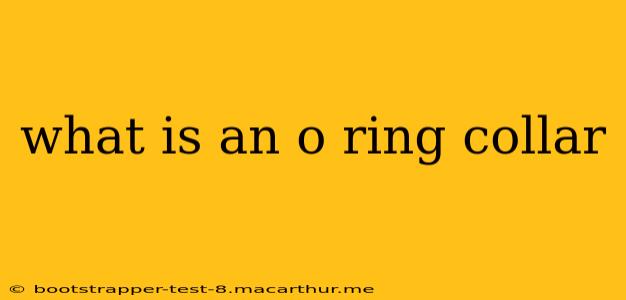An O-ring collar, also known as an O-ring seal or simply an O-ring, is a simple yet incredibly versatile mechanical seal. It's a torus (donut-shaped) ring made from a variety of elastomeric materials, designed to create a leak-proof seal between two or more mating surfaces. Its effectiveness comes from its ability to deform and conform to the surfaces it contacts, creating a pressure-tight fit. This makes O-ring collars crucial components in countless applications across numerous industries.
What are O-Rings Made Of?
O-rings are manufactured from a wide range of elastomers, each chosen for its specific properties and suitability for the intended application. Common materials include:
- Nitrile (Buna-N): A popular choice due to its good resistance to oils, fuels, and many chemicals. It offers a balance of cost-effectiveness and performance.
- Ethylene Propylene (EPDM): Excellent resistance to heat, ozone, and weathering, making it suitable for outdoor and high-temperature applications.
- Silicone: High-temperature resistance and good flexibility, often used in medical and food-processing applications where biocompatibility is vital.
- Viton (FKM): Exceptional resistance to a wide range of chemicals, solvents, and high temperatures. A more expensive option but ideal for demanding environments.
- Neoprene: A versatile material offering good resistance to oils, fuels, and water, often used in general-purpose applications.
The choice of material depends critically on the operating conditions, including temperature, pressure, and the nature of the fluids or gases being sealed.
How Does an O-Ring Collar Work?
The magic of an O-ring lies in its ability to create a seal through compression. When installed in a groove, the O-ring is compressed between two mating surfaces. This compression causes the O-ring to deform and fill the microscopic imperfections on the surfaces, effectively blocking the passage of fluids or gases. The sealing pressure is generated by the system pressure itself, further enhancing the seal's integrity.
What are the Different Types of O-Ring Collars?
While the basic design remains consistent, variations exist depending on the specific application and requirements:
- Standard O-Rings: The most common type, used in a wide range of applications.
- Back-up Rings: Used in conjunction with standard O-rings to provide additional support and prevent extrusion under high pressure.
- Metric O-Rings: Manufactured to metric dimensions, commonly used in European and international applications.
- Specialty O-Rings: Designed with specific features, such as coatings or specialized materials, to address unique sealing challenges.
What are Some Common Applications of O-Ring Collars?
The widespread use of O-rings stems from their reliability and cost-effectiveness. They are found in countless applications, including:
- Automotive: Sealing engine components, fuel systems, and hydraulic systems.
- Aerospace: Sealing critical components in aircraft and spacecraft.
- Industrial Machinery: Sealing valves, pumps, and other components in various industrial processes.
- Medical Devices: Used in various medical devices where leak-proof seals are crucial.
- Plumbing and Hydraulics: Sealing fittings and preventing leaks in fluid systems.
How to Choose the Right O-Ring Collar?
Selecting the appropriate O-ring requires careful consideration of several factors:
- Material Compatibility: The O-ring material must be compatible with the fluids or gases it will be sealing.
- Operating Temperature: The O-ring must be able to withstand the operating temperature range.
- Pressure: The O-ring must be able to withstand the system pressure.
- Size and Dimensions: The O-ring must be the correct size to fit the groove and mating surfaces.
Incorrect selection can lead to leaks, premature failure, and potential damage to the system.
What are the Advantages of Using O-Ring Collars?
O-rings offer numerous advantages, making them a preferred sealing solution in countless applications:
- Simplicity and Ease of Installation: Relatively easy to install and replace.
- Cost-Effectiveness: Generally inexpensive compared to other sealing methods.
- Reliability: Proven track record of reliable sealing performance.
- Versatility: Suitable for a wide range of applications and operating conditions.
- Wide Material Availability: A vast selection of materials to choose from, ensuring compatibility with various fluids and temperatures.
What are the Disadvantages of Using O-Ring Collars?
While O-rings offer significant advantages, it's essential to be aware of their limitations:
- Limited Temperature Range: The operational temperature range depends on the material used.
- Susceptibility to Chemical Attack: Some materials are vulnerable to specific chemicals.
- Potential for Extrusion: Under high pressure, the O-ring may extrude from the groove.
- Static Seals: They are static seals, not dynamic, meaning they don't work well in applications with moving parts requiring continuous sealing.
By understanding the strengths and weaknesses of O-ring collars, engineers and technicians can make informed decisions and select the appropriate solution for their specific application. Proper selection and installation are key to ensuring reliable and long-lasting sealing performance.
